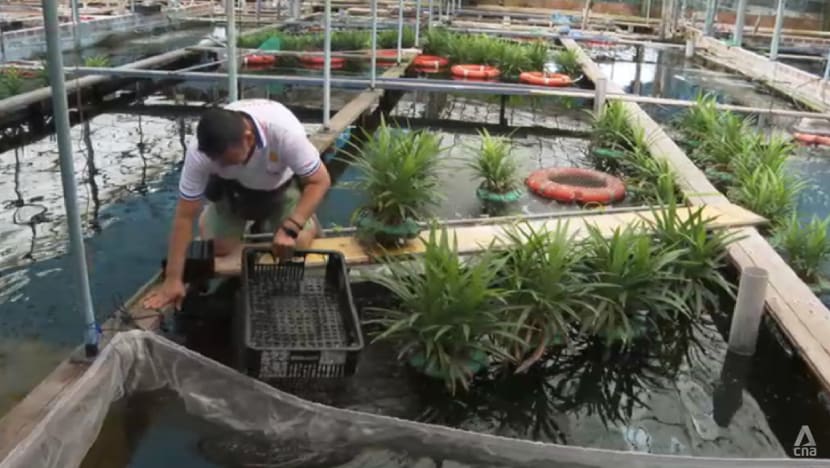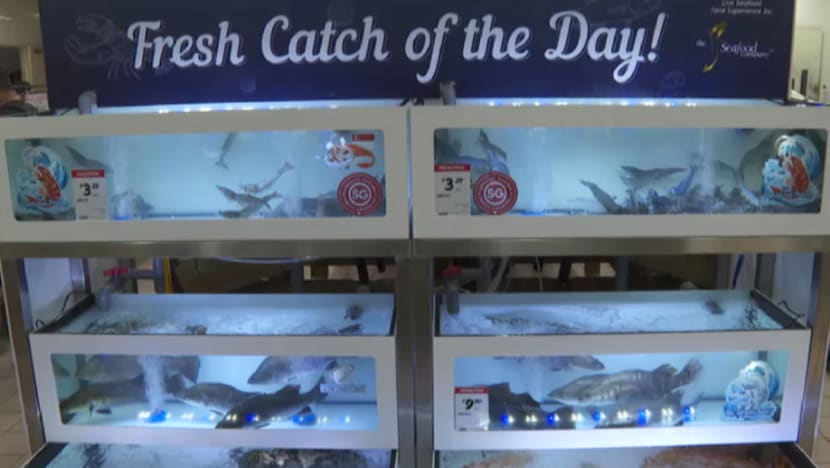Live, locally-grown shrimp and fish now on sale at 3 Giant supermarkets

Live shrimp for sale at Giant Hypermarket in Tampines.

This audio is generated by an AI tool.
SINGAPORE: Supermarket customers will now be able to purchase locally farmed live seafood at three Giant outlets.
Giants branches at Tampines North, IMM and Tengah Plantation Plaza will feature in-store aquatic tanks for fish – including grouper, marine tilapia and sea bass – and vannamei shrimp.
This is the first time live, locally produced shrimp is being sold at supermarkets.
The initiative by farm aggregator Singapore Agro-Food Enterprises Federation (SAFEF) comes amid national efforts to accelerate local food production.
The organisation is working with three land-based farms to supply 2 tonnes of live shrimp every month. Depending on sales figures, they hope to bump up the amount by 10 times to 20 tonnes in a few months.
“If the market response is good, we can scale up,” said the federation’s CEO Ken Cheong. “Prawns’ growth cycle is much shorter, so we can … pace it together with market demand.”
FROM FARM
One of the farms supplying the live shrimps is Nippon Koi Farm in Sungei Tengah, which has been breeding fish since the 1970s.
Owner Pay Bok Sing said he was initially not keen on shrimp farming as he struggled with procuring healthy shrimp larvae. A single disease-stricken shrimp could infect a whole pond within a day.
SAFEF then established a surveillance process to test shrimp larvae for disease the moment they reach Singapore. It takes just an hour to get results, before they reach local aquaculture farms.
The federation is casting its net wider for larvae imports – previously only from Malaysia – to include China and Vietnam.
It also helps farmers source better feed to grow higher-quality produce, and its consultants provide farms with advice on improving their setup and processes.
Mr Pay told CNA that he initially did not really want to conduct prawn farming on a large scale. However, SAFEF later helped establish connections for the procurement of baby shrimp and feed, and advised on how to control disease.
“They've given us a lot of support. Then my mind started to change to want to convert the farm to a shrimp farm,” he said.
Decades of fish farming have helped Mr Pay's family business innovate its own aquaculture systems to optimise space and save costs.
He designed what he calls “shrimp condominiums” for his crustaceans – involving perforated plastic crates stacked on top of each other, creating multiple layers that his shrimp can swim in and out of.

He said this helps to spread the shrimp out so that they do not end up eating each other. Additionally, the structure gives them ample space to rest, which reduces their consumption of oxygen.
The simple invention has allowed the farm to increase the number of shrimp reared by four times – from 200 shrimp per sq m, to more than 800 – in the same space, according to Mr Pay.
He also said his farm uses a water management and filtration system that recycles the water used in the ponds, reducing costs while promoting environmental sustainability.
TO SUPERMARKET
SAFEF already sells locally-sourced seafood and vegetables to other major supermarkets in Singapore including FairPrice and Sheng Siong.
Mr Cheong said consumers’ response has been positive and demand is growing, allowing local farmers to ramp up output. Production of vegetables by its farm partners has been scaled up by more than five times and fish production by four times since May last year.
SAFEF's launch at Giant Tampines Hypermarket on Tuesday (Aug 19) will further increase that demand, kicking off the sale of its aggregated produce at 38 Cold Storage and Giant outlets across the island.

Minister of State for Culture, Community and Youth Baey Yam Keng called the launch a “milestone” that will propel Singapore towards its “30 by 30” goal to produce 30 per cent of the nation’s nutritional needs by 2030.
“This will reinforce our commitment to champion local farmers and expand the market for local produce,” said Mr Baey, who is MP for Tampines GRC.
“Because they are straight from the farm to the supermarket, they are fresher, and they can last longer. (They also) incur less transport miles to reach shelves, so that is also good for the environment, with lower emissions.”
He highlighted challenges Singapore faces when it comes to food, including climate change affecting crop yield, geopolitical tensions affecting trade, as well as the nation’s limited land resources for farming.
“Building local production capabilities is a shared responsibility among different stakeholders, including the government, industry players and consumers,” he said.
“More importantly, all these collective efforts will strengthen the Singapore food story and increase our resilience in our food source.”















